Distinguishing different cuts of meat can be confusing since retailers and restaurants often offer them under different names.
Prime examples of this are the bottom round and rump roast which are used interchangeably in many recipes but are two entirely separate pieces of beef.
Even though both come from the hip, the rump is separated by the bottom round by a straight cut to the aitch bone.
This seemingly insignificant difference plays a major role in the tenderness of these meats and the way they are cooked.
In this article, I’ll take a deeper look into all of the differences between the bottom round and the rump roast , so you can make the best out of each cut.
What are the main differences – rump roast versus bottom round?
The bottom round and rump roast differ in three main areas: tenderness, cooking applications and preparation.
Each of these differences affects the way these beef cuts are utilized in cooking.
Let’s look at them in detail.
Tenderness
One of the most important aspects of high-quality beef is tenderness.
Tender beef cuts can typically be distinguished by the thin white threads of fat they are veiled in.
This threaded pattern is referred to as marbling in the beef industry and it’s used to determine the overall quality of the meat.
Premium cuts such as the rib eye and porterhouse have a pronounced marbling pattern, whereas lower-grade ones such as the eye of round barely have any visible fat.
Consequently, the tougher pieces of meat are classified by the USDA as either lean or extra lean depending on the amount of fat they have.
The bottom round and rump roast are both classified as extra lean cuts since they have less than 10 grams of fat per serving.
There’s a catch though.
Let’s see if you’ll spot it.
Here’s what a rump roast looks like:
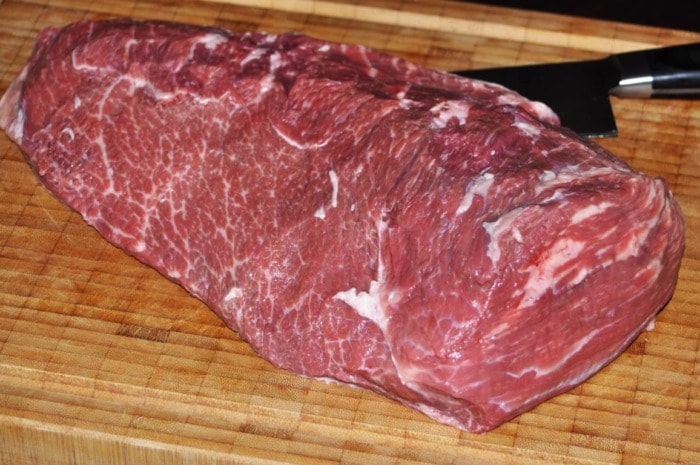
by Spätzünder
And here’s a picture of a bottom round:
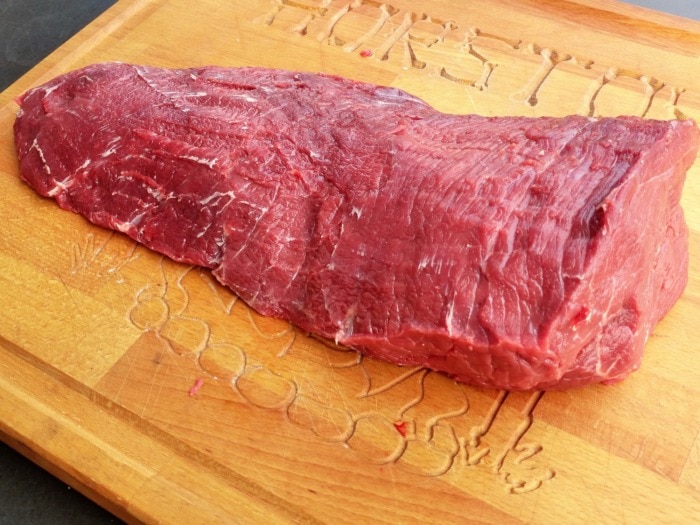
by Horst04
Notice how the rump roast has more marbling?
Well, that’s because it is located in an area that receives less exercise so it has more fat as a result.
The rump roast is the rounded area at the rear end of the cow, while the bottom round is located just beneath it.
Let me help with the visualization:
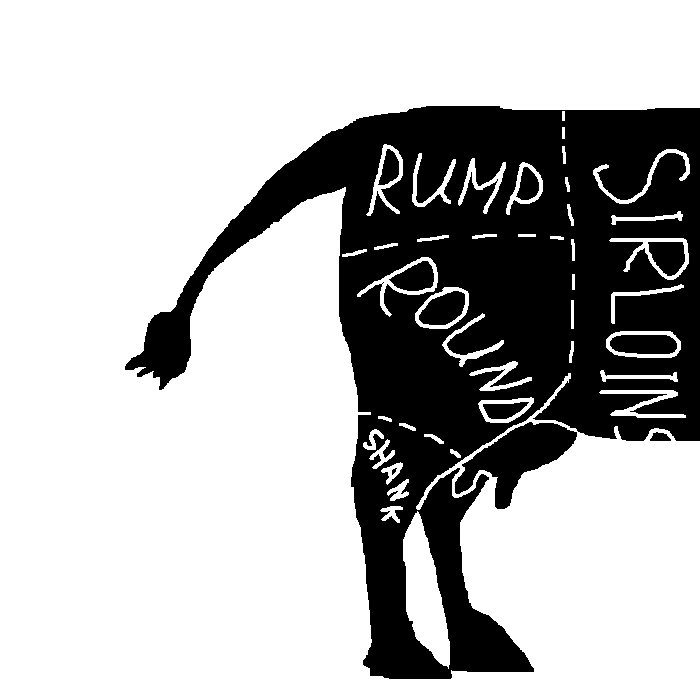
Due to these differences in fat content, the rump roast is more tender than the bottom round.
Preparation
Since the bottom round takes an extremely long time to cook, it sometimes needs a bit of preparation beforehand.
The most popular preparation methods that are used to shorten the cooking time for bottom round are butterflying and the accordion cut.
Butterflying is a cutting technique in which you split a piece of meat by making a horizontal slice through the middle.
The accordion cut on the other hand is similar to butterflying, but it’s used to make a series of alternating vertical cuts instead of a single horizontal cut.
Another preparation method that often goes hand-in-hand with the bottom round is tenderizing.
Tenderizing can be useful if you’re making a swiss steak or another dish that requires the meat to be less chewy.
But if I have to be honest, I would prefer to get a top round steak instead because they’re a bit more tender.
They’re also readily available at most butcher shops so you don’t need to prepare the meat yourself.
You may be interested in checking: Keto Cube Steak for Crock Pot Recipe
Unlike the bottom round, the rump roast usually requires little to no preparation since it’s mostly used for stews.
Apart from seasoning, there isn’t much else that you need to do.
Cooking Applications
The bottom round and rump roast are typically used for different cooking purposes.
Since the bottom round has an extremely low amount of fat, it is mostly used to make cold cuts or beef jerky.
However, it can also be smoked at a temperature of 225°F (108°C) for 2 – 3 hours or until it reaches an internal temperature of 140°F (60°C).
I recommend using oak for smoking as it reaches a high temperature, burns slowly and lends a mild flavor to the meat.
It’s also worth noting that with proper handling the bottom round can also be used to make swiss steak.
Compared to the bottom round, the rump roast is mostly good for stews and pot roast.
How to cook rump roast and bottom round?
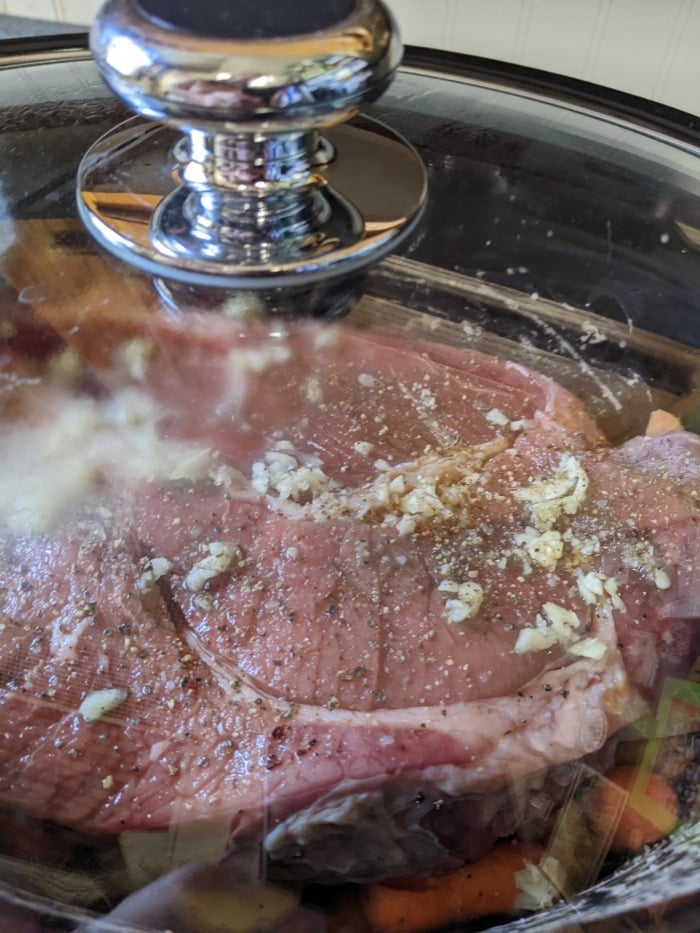
by mikelieman
Even though both the rump roast and bottom round contain little to no fat, they can still taste tender.
Most people falsely attribute tenderness solely to the type of meat they buy, without taking into account the way they prepare it.
Unfortunately, they fail to realize that you can turn any piece of meat into tenderized goodness as long as you cook it at a low temperature.
Cooking tough cuts of beef at a low temperature, allows collagen to fully break down and turn into gelatin.
This softens up their meat and makes it more tender.
Therefore the best way to make these lean cuts melt in your mouth is to use “low and slow” cooking techniques such as braising and stewing.
You should avoid dry heat cooking methods since they will burn the meat before it’s cooked on the inside.
Due to the higher fat content of rump roast, it is a better choice for roast beef than the bottom round.
You can also use it as an alternative to the slightly more juicy chuck roast.
Author’s note: If you decide to rump roasts as a substitute, you should first sear the meat to prevent any juices from escaping during cooking.
Apart from these tried and true methods, you can also smoke both the bottom round and rump roast.
Whenever I have my hands on a piece of rump roast, I like to smoke it over the grill for some beef sandwiches.
It’s an easy way to take advantage of an otherwise tough piece of meat.
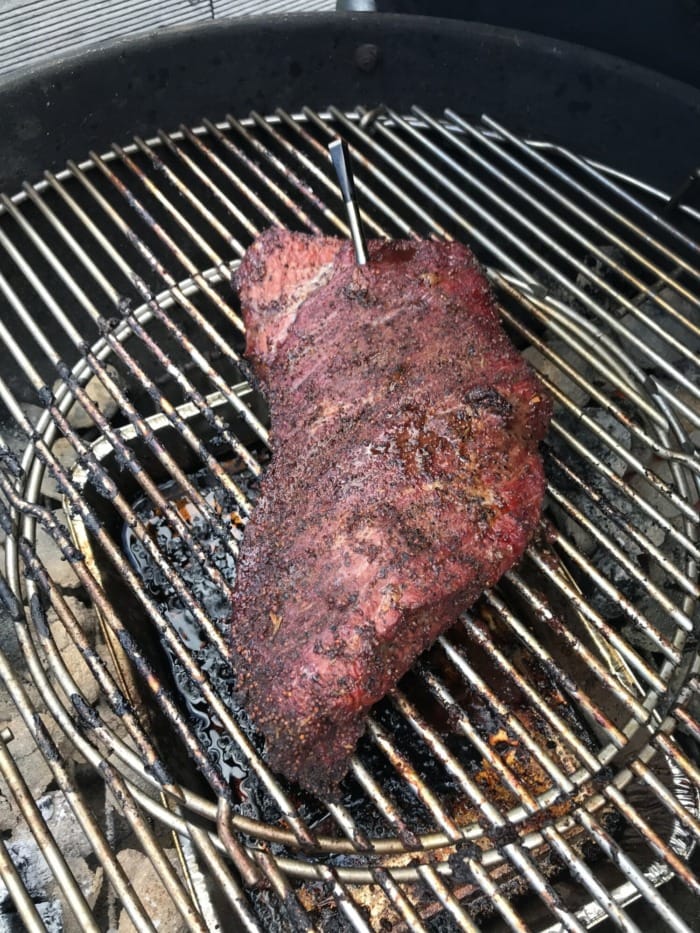
by pellinger
I usually smoke it for 2 – 3 hours or until it reaches an internal temperature of 135°F (around 57°C).
To season it, I use a mixture of paprika, salt, cayenne pepper, black powder and mustard powder for my dry rub.
Here is a list of all the ingredients for my dry rub:
- 1 tbsp Paprika
- 1 tbsp Salt
- 1/8 tbsp Cayenne Pepper
- 1 tbsp Black Pepper
- 1 tbsp Onion Powder
- 1 tbsp Garlic Powder
- 1 tbsp Mustard Powder
You may be interested in checking: The Best Smoked Salmon: Internal Temperature Guide
The Bottom Line
Bottom round and rump roast can be great cuts of meat whether you like the pungent flavor of smoked beef or the savory taste of pot roast.
Despite their poor reputation, these cuts are a good source of protein which can be just as flavorful as some more expensive pieces of meat.
Telling which of them is better will largely depend on the way you’re going to prepare them.
The higher fat content of rump roasts makes them a better choice for stews, whereas the bottom round has a slight edge when it comes to cold cuts.
If you’re still wondering what to do with your beef, then you can try my Spicy Pot Roast recipe below.
And don’t forget to comment, I’ll love to hear how your roasts have turned out!